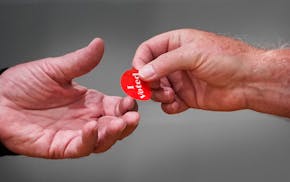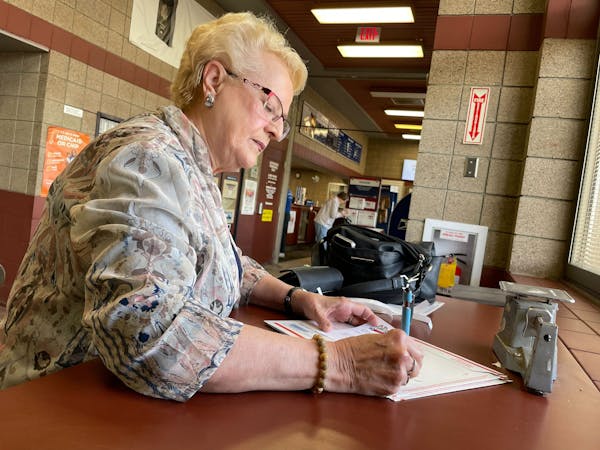President Donald Trump claimed Tuesday night in the State of the Union address that the changes he wants to U.S. immigration laws are needed to keep Americans safe. The central piece of evidence in his argument was MS-13, the deadly gang also known as Mara Salvatrucha.
"Tonight, I am calling on the Congress to finally close the deadly loopholes that have allowed MS-13 and other criminal gangs to break into our country," Trump said. He also invited the parents of two young women killed by MS-13 members in Long Island to be his guests at the speech.
But in pointing to MS-13 to try to scare Americans into harsh new immigration restrictions, Trump is overstating the danger the gang poses here in the United States. Worse, by using the gang to demonize all Latino immigrants, Trump is building inner-city walls that alienate communities and risk making criminal organizations more powerful, both here and overseas.
MS-13 is considered one of the most violent youth gangs in the Western Hemisphere. According to various estimates, more than 30,000 MS-13 gang members are roaming the streets of what's known as the "Northern Triangle" of Central America, a region made up of El Salvador, Guatemala and Honduras. There, Mara Salvatrucha, along with its archenemy, the 18th Street gang, contribute significantly to record levels of violence. MS-13 is indeed a threat to countries that the president apparently considers to be "shitholes."
Things are different in the U.S. According to Justice Department estimates, MS-13 is a small gang, compared with the Bloods, Crips and Almighty Latin King Nation. The estimated 10,000 MS-13 gang members in the U.S. account for less than 1 percent of the estimated 1.4 million total gang members in the country. According to CNN, 104 of the 1,300 gang members arrested during an Immigration and Customs Enforcement sweep last May — 8 percent — were linked to MS-13.
And the gang did not come from south of the border. MS-13 is as American-made as Google — or, for that matter, as Trump. MS-13 was founded in Los Angeles in the 1980s by children of Salvadoran immigrants who fled a brutal civil war, which was substantially funded by the U.S. The early members were teenagers who hung out on street corners and bonded around reefer and rock concerts, not unlike thousands of other kids living in Southern California's underprivileged communities.
Things started to change when many of the same kids were arrested during massive "anti-gang" police operations in the 1980s and ultimately sent to juvenile centers across California. Those sweeps, part of a militaristic zero-tolerance response to the nation's social problems, failed to acknowledge that such problems were the direct result of underfunded social programs and systemic marginalization. Instead of serving as a deterrent, they further weakened social ties and increased exclusion, and thus facilitated the transformation and consolidation of MS-13 into a serious criminal enterprise. It was in the juvenile centers and prisons that local kids — joined soon by immigrants — interacted with hardened criminals and learned how to run a gang. The criminal bent that shaped MS-13 emerged from U.S. prisons and juvenile centers, not from countries south of the border.
The Clinton administration made things worse after the enactment of the Illegal Immigration Reform and Immigrant Responsibility Act of 1996, deporting thousands of foreign-born residents convicted of crimes. The deportations turned the gang loose in El Salvador and its neighbors. Gang members went from California jails to Central American streets.
And Central American nations made the same mistakes the U.S. had. Governments there applied the same zero-tolerance law enforcement approach to problems facing deprived and restless young people. Draconian "mano dura" ("hard hand") programs led to Central American prisons being flooded with gang members and underprivileged young people alike. Just as in the U.S., these gang members networked with and learned from vicious drug cartel members and corrupt authorities. Spurred by law enforcement's continued heavy-handed response, MS-13 came under siege in a war with authorities and transformed into the brutal street gang that now besieges the people of El Salvador, Honduras and Guatemala.
Now Trump is repeating the errors of the past by raising the profile of MS-13 and using it to generate fear of immigrants. In contrast to Central America, Mara Salvatrucha in the U.S. remains a problem limited to a handful of areas along the East Coast, in which some teenagers have committed vile criminal acts primarily against members of their own communities. MS-13 in the U.S. does not rule cities as it does in Central America (though Trump claimed it does). It has no official national leadership structure here and does not collude with corrupt politicians to win elections.
By misleadingly designating MS-13 as a national priority for the Justice Department and simultaneously stepping up anti-immigration rhetoric and raids of Latino communities, the administration is only encouraging the gang and others like it to flourish here. Massive crackdowns will populate juvenile detention centers and prisons in the U.S., and relentless deportations will increase the number of criminals roaming the streets in Central America, just as in the 1980s and 1990s. The combined effects of Trump's war on immigrants and street gangs will create communities that are even more alienated from law enforcement and more isolated from the institutions that can protect and improve the lives of the people there.
Trump's strategy will prove even more reckless than those of his predecessors. It will generate the perfect conditions for prison gangs and street gangs to thrive in the U.S. and abroad. It will further isolate our disadvantaged and poor communities, and these neighborhoods will, indeed, end up being occupied by brutal criminal groups and corrupt politicians capitalizing on people's desperation. Trump's warnings of a brutal, emboldened MS-13 here in the U.S. will become a self-fulfilling prophecy. And anti-immigrant sentiment will grow even more.
José Miguel Cruz is director of research in the Kimberly Green Latin American and Caribbean Center at Florida International University. He has conducted research on Central American gangs since 1996. He wrote this article for the Washington Post.
For Mother's Day, I don't want brunch. We need a cease-fire.



